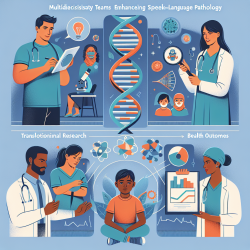Unlocking the Secret to Better Child Outcomes: What Every Practitioner Needs to Know About Psychosis Prevention
As a speech-language pathologist dedicated to enhancing child outcomes, understanding the broader context of mental health interventions can be pivotal. A recent systematic review titled "Public health primary prevention implemented by clinical high-risk services for psychosis" offers valuable insights into how clinical high-risk (CHR-P) services for psychosis are adopting public health approaches to improve mental health outcomes. This blog explores the findings of this review and provides actionable insights for practitioners looking to enhance their skills and contribute to better child outcomes.
Understanding the CHR-P Model
CHR-P services are designed to support young individuals who exhibit early signs of psychosis. These services not only focus on indicated prevention but also implement numerous public health initiatives targeting various social determinants of mental disorders. The systematic review analyzed 66 publications and identified that CHR-P services are actively engaging in public health initiatives that address social, economic, demographic, environmental, and neighborhood factors linked to mental health.
Key Findings and Their Implications
- Social and Cultural Interventions: CHR-P services implement initiatives that enhance mental health literacy and reduce stigma. For practitioners, this underscores the importance of incorporating educational components in therapy sessions to promote mental health awareness among children and their families.
- Economic and Vocational Support: By focusing on vocational history and goals, CHR-P services help improve occupational performance. Practitioners can integrate goal-setting and cognitive skills training in their practice to support children’s academic and occupational aspirations.
- Demographic and Community Engagement: Services are located in diverse communities and engage in outreach to ethnic minorities. Practitioners should consider culturally responsive practices to ensure inclusivity and effectiveness in diverse populations.
Practical Steps for Practitioners
To implement these findings, practitioners can take the following steps:
- Enhance Mental Health Literacy: Incorporate psychoeducation into therapy sessions to improve understanding and reduce stigma around mental health issues.
- Support Vocational and Academic Goals: Use data-driven strategies to set realistic goals and track progress in academic and occupational areas.
- Engage with Communities: Build partnerships with local organizations to create a supportive network for children and families.
Encouraging Further Research
While the review provides a comprehensive overview of public health initiatives in CHR-P services, it also highlights gaps in research, particularly in low- and middle-income countries. Practitioners are encouraged to contribute to research efforts by documenting outcomes and sharing insights from their practice.
To read the original research paper, please follow this link: Public health primary prevention implemented by clinical high-risk services for psychosis.










